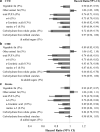Dairy Products, Dairy Fatty Acids, and the Prevention of Cardiometabolic Disease: a Review of Recent Evidence
- PMID: 29564646
- PMCID: PMC5990967
- DOI: 10.1007/s11883-018-0724-z
Dairy Products, Dairy Fatty Acids, and the Prevention of Cardiometabolic Disease: a Review of Recent Evidence
Abstract
Purpose of review: To examine recent literature on dairy products, dairy fatty acids, and cardiometabolic disease. Primary questions of interest include what unique challenges researchers face when investigating dairy products/biomarkers, whether one should consume dairy to reduce disease risk, whether dairy fatty acids may be beneficial for health, and whether one should prefer low- or high-fat dairy products.
Recent findings: Dairy composes about 10% of the calories in a typical American diet, about half of that coming from fluid milk, half coming from cheese, and small amounts from yogurt. Most meta-analyses report no or weak inverse association between dairy intake with cardiovascular disease and related intermediate outcomes. There is some suggestion that dairy consumption was inversely associated with stroke incidence and yogurt consumption was associated with lower risk of type 2 diabetes. Odd chain fatty acids (OCFAs) found primarily in dairy (15:0 and 17:0) appear to be inversely associated with cardiometabolic risk, but causation is uncertain. Substitution analyses based on prospective cohorts suggested that replacing dairy fat with vegetable fat or polyunsaturated fat was associated with significantly lower risk of cardiovascular disease. Current evidence suggests null or weak inverse association between consumption of dairy products and risk of cardiovascular disease. However, replacing dairy fat with polyunsaturated fat, especially from plant-based foods, may confer health benefits. More research is needed to examine health effects of different types of dairy products in diverse populations.
Keywords: Cardiovascular disease; Dairy; Odd chain fatty acids; Saturated fat; Yogurt.
Conflict of interest statement
Dr. Edward Yu declares no conflict of interest.
Figures




References
-
- Gaucheron F. Milk and dairy products: a unique micronutrient combination. J Am Coll Nutr. 2011;30(5 Suppl 1):400s–9s. - PubMed
-
- Sacks FM, Lichtenstein AH, Wu JHY, Appel LJ, Creager MA, Kris-Etherton PM, et al. Dietary fats and cardiovascular disease: a presidential advisory from the American Heart Association. Circulation. 2017;136:e1–e23. - PubMed
-
- Agriculture USDo. [cited 2017 July 26];Food Availability (Per Capita) Data System 2016. Available from: https://www.ers.usda.gov/data-products/food-availability-per-capita-data...
-
- SR28 U. National Nutrient Database for Standard Reference, Release 28. US Department of Agriculture, Agricultural Research Service, Nutrient Data Laboratory. 2016;26 http://wwwarsusdagov/ba/bhnrc/ndl Accessed.
Publication types
MeSH terms
Substances
Grants and funding
LinkOut - more resources
Full Text Sources
Other Literature Sources
Research Materials

